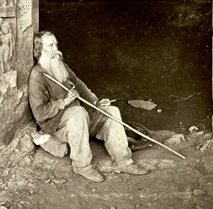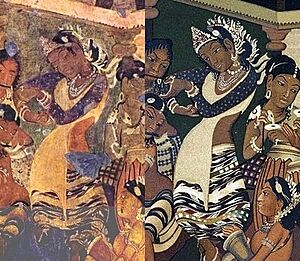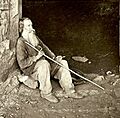Robert Gill facts for kids
Quick facts for kids
Robert Gill
|
|
|---|---|

Gill at Ajanta
|
|
| Born | 26 September 1804 Hackney, London, England
|
| Died | 10 April 1879 (aged 74) en route from Ajanta to Bhusawal, India.
|
| Resting place | European Cemetery, Bhusawal |
| Occupation | Army officer, artist, photographer, sportsman |
| Known for | copying the paintings of Ajanta Caves. |
| Spouse(s) | Frances Flowerdew Rickerby |
Major Robert Gill (1804–1879) was a British army officer, artist, and photographer. He lived and worked in British India. He is most famous for his amazing paintings that copied the ancient frescoes inside the Ajanta Caves.
Gill was the first artist to make many copies of these Buddhist cave paintings after they were rediscovered in 1819. Most of these paintings are from the 5th century CE. His copies and drawings are very important today. They help us understand what the original paintings looked like, because many of them have faded or been damaged over time.
Contents
Robert Gill's Life Story
Early Life and Army Career
Robert Gill was born in Hackney, London, in 1804. His father worked as a stockbroker. When he was 20, in 1824, Gill joined the 44th Madras Native Infantry. He quickly moved up the ranks.
He became an ensign in 1825 and a lieutenant in 1826. By 1840, he was a captain, and later he became a major. In 1841, he married Frances Flowerdew Rickerby in London. They had several children together. Their first child, Frances Eliza Minchin Gill, was born in Madras. Their son, William John Gill, who later became a soldier and explorer, was born in Bangalore.
Working at the Ajanta Caves
In 1844, Robert Gill was asked to stop his regular army duties. Instead, he was given a special job: to copy the murals at the Ajanta Caves. This was a huge task, and he spent about 30 years there. He measured, mapped, cataloged, photographed, and painted the caves. He even faced dangers from wild animals and local people.
Gill arrived at Ajanta in early 1845 and started his work. He began sending his finished paintings back to London in 1847. Many of these were shown at the East India Company museum. Some of his works were even featured in the Illustrated London News in 1849.
By 1863, Gill had copied about 30 of the main frescoes onto canvas. These copies were almost the same size as the originals. Sadly, many of his valuable paintings were lost. In 1866, 25 of his pictures were destroyed in a fire at The Crystal Palace in London. Another painting was lost in a fire at the South Kensington Museum (now the Victoria and Albert Museum) in 1885.
The four copies that survived are now kept at the Victoria and Albert Museum in London. Many of his drawings can also be found at the British Library.
Photography and Legacy
Robert Gill also became a photographer around 1856. He took many pictures, including stereoscopy photos, which create a 3D effect. His photographic work was published in two books: The Rock-Cut Temples of India and One Hundred Stereoscopic Illustrations of Architecture and Natural History in Western India.
Gill's surviving photographs, drawings, and paintings are very important for people who study Ajanta and Indian art. They show us what the original paintings looked like before they started to fade and flake away. The caves began to deteriorate quickly after they were rediscovered in 1819. Even in Gill's time, the original paintings were being damaged by visitors, bees, and bats.
His work also shows the condition of the stone carvings at the time. Some parts have since been lost or repaired. Many of his plans, drawings, and photographs are available online through the British Library.
Later Life and Death
Robert Gill stayed at Ajanta for the rest of his life. He also traveled to other ancient sites across India. He was a keen hunter and is said to have hunted around 150 tigers.
He passed away in 1879 while being moved from Ajanta to Bhusawal because he was very ill. He was buried at the European Cemetery in Bhusawal.
Images for kids




